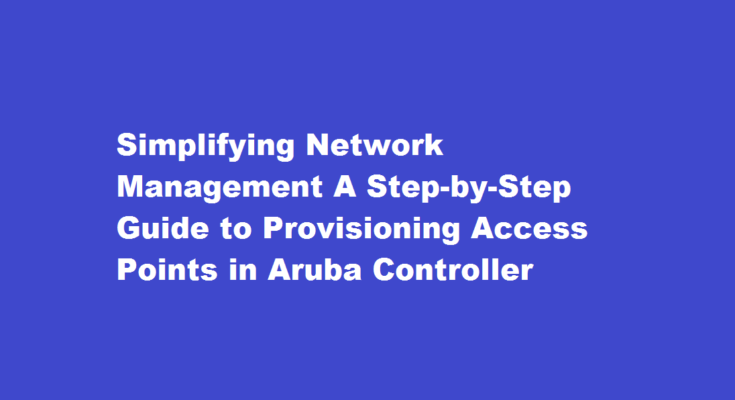Introduction
In today’s digital age, reliable and efficient Wi-Fi connectivity is crucial for businesses and organizations. Aruba Networks, a leading provider of network infrastructure solutions, offers a powerful centralized management platform called the Aruba Controller. This article aims to guide network administrators and IT professionals through the process of provisioning access points (APs) in the Aruba Controller, ensuring a seamless and secure wireless network deployment.
Understanding the Aruba Controller
The Aruba Controller acts as a central hub for managing and controlling wireless access points within a network. It provides a unified interface to configure, monitor, and troubleshoot APs, allowing administrators to efficiently manage their wireless infrastructure.
Preparing for AP Provisioning
Before provisioning APs, it is essential to gather some preliminary information. Begin by identifying the desired AP deployment locations, considering factors such as signal coverage and user density. Determine the appropriate AP models and quantities required for each location, and ensure they are compatible with the Aruba Controller. Additionally, gather the necessary network settings, such as IP addresses and VLAN configurations.
Connecting APs to the Network
Start by physically connecting the APs to the network. Ensure they are powered on and connected to the appropriate PoE (Power over Ethernet) switch ports. The APs will automatically discover the Aruba Controller, establish a secure connection, and obtain their configurations.
Configuring the Aruba Controller
Access the Aruba Controller’s web-based management interface and navigate to the AP provisioning section. Here, you can configure general settings, such as time zone, security settings, and network profiles. Network profiles define the wireless network’s behavior, including SSID, authentication, and encryption settings. Customize these profiles to align with your organization’s requirements.
Adding APs to the Aruba Controller
In the Aruba Controller interface, locate the AP provisioning section and select “Add AP.” Provide the necessary details, including the AP’s serial number and MAC address. The Aruba Controller will automatically recognize and validate the AP, ensuring its authenticity. Once validated, assign the AP to a specific network profile and define its location within the network topology.
Monitoring and Troubleshooting
Once the APs are provisioned, the Aruba Controller provides extensive monitoring and troubleshooting capabilities. It allows administrators to view real-time status information, such as client connectivity, signal strength, and network utilization. In the event of any issues, the controller offers diagnostic tools to pinpoint and resolve problems quickly.
Scaling and Expanding the Network
As your organization grows or the wireless infrastructure needs to expand, the Aruba Controller simplifies the process. Adding new APs to the network involves repeating the provisioning steps mentioned earlier, ensuring they are assigned to appropriate network profiles and locations. The centralized management provided by the Aruba Controller streamlines network expansion without compromising on security or performance.
FREQUENTLY ASKED QUESTIONS
How do I add an access point?
Use an Ethernet cable to connect the access point to the router. The cable should be inserted into a LAN port on the router and into the main Ethernet port on the access point. This introduces the access point to the router’s created local area network. Use an Ethernet cable to connect the router to the computer.
What is AP mode in Aruba?
A network protocol that enables a server to automatically assign an IP address to an IP-enabled device from a defined range of numbers configured for a given network. server. Management frames on the AP.
Conclusion
Provisioning access points in the Aruba Controller enables organizations to deploy and manage their wireless network efficiently. By following the step-by-step guide outlined in this article, network administrators can streamline the configuration process, ensuring reliable and secure connectivity. The Aruba Controller’s centralized management interface offers extensive monitoring and troubleshooting capabilities, empowering administrators to maintain a high-performing wireless network infrastructure. Whether you are provisioning APs for a small office or a large enterprise, leveraging the power of the Aruba Controller simplifies the task and provides a solid foundation for your wireless network deployment.
Read Also : Simplifying Virtual Machine Provisioning in Azure A Step-by-Step Guide



